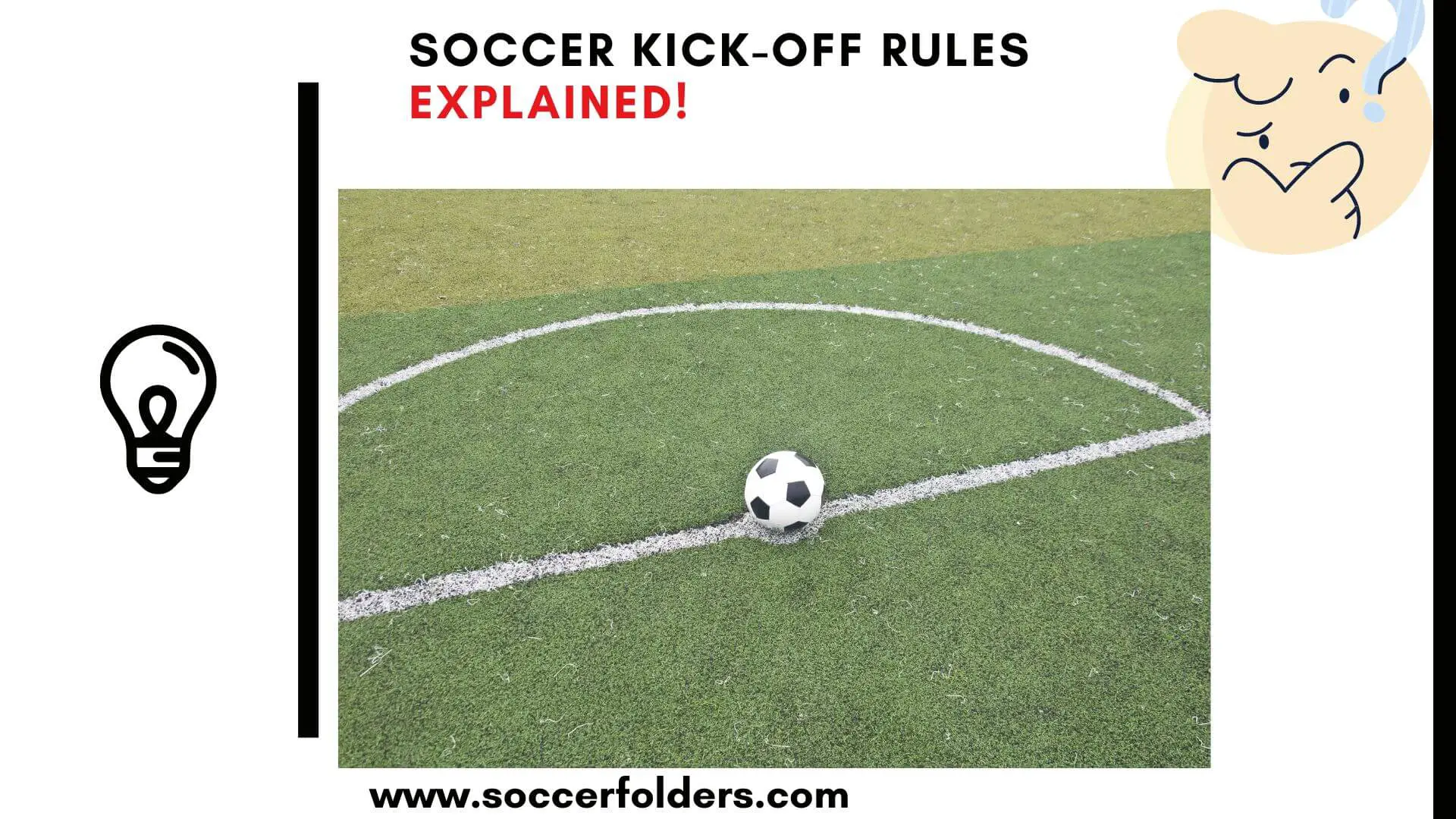Soccer, also known as football in many parts of the world, is a popular sport that captivates fans with its fast-paced action and strategic gameplay. One crucial aspect of soccer is the kick-off, which marks the beginning of each half and after a goal is scored.
In this article, we’ll delve into the fundamental soccer kick off rules, making it easy for newcomers and enthusiasts to grasp this essential part of the game.
Let’s get started.
Table Of Contents
Understanding the Basics and Soccer Kick-Off Rules
The kick-off is the starting point of a soccer match. It takes place at the centre circle of the field, and it symbolizes both teams’ readiness to engage in the battle for victory.
The team winning the coin toss gets the privilege of choosing whether to start with the ball or pick a preferred goal to defend.
1. The Starting Team

Before the game begins, a coin toss determines which team gets to choose the side of the field and which team gets to start with the ball. The team that wins the coin toss can decide whether they want to start with the ball or choose a specific goal to attack.
2. Location
The kick-off takes place at the center circle of the field. All players from both teams must be on their respective halves of the field, and the opponents of the kicking team must be at least ten yards away from the ball.
3. Inbound Ball
The ball is considered “in play” as soon as it is kicked and moved. This means that any player can now move to gain possession of the ball and continue the game.
4. Scoring a Goal
Believe it or not, a goal can actually be scored directly from a kick-off! If the ball is kicked directly into the opponent’s goal without any other player touching it, it counts as a goal.
However, this is a rare occurrence due to the distance from the center circle to the goal.
5. Second Half Kick-Off
After halftime, the teams switch sides, and the team that did not start the first half with the ball gets the chance to kick off and start the second half.
Executing a Proper Kick-Off
When the referee’s whistle signals the start of the match, the ball must move from the center circle.
One crucial rule to remember is that the player performing the kick-off cannot touch the ball again until another player makes contact.
This means that a teammate must touch the ball before the kicker can be in control once more.
Different Scenarios and Exceptions
While the fundamental procedure of kick-off is quite straightforward, there are specific scenarios and exceptions that can arise, adding an intriguing layer to this initial action.
In some cases, the anticipated kick-off might not go as planned, prompting the need for a retake.
1. Ball Movement
A crucial aspect of kick-offs is the movement of the ball. During the initial kick-off, the ball must be played either forward or backwards, indicating the start of active play.
While teams are allowed to pass the ball to a teammate in their own half, the ball’s first touch must move it outside the center circle. This ensures that the kick-off contributes to the progression of the game rather than merely being a stationary action.
If this condition is not met, the kick-off may be retaken to ensure compliance with this rule.
This rule emphasizes the intention to actively engage in the game right from the start of play.
2. Minimum Distance
Another pivotal aspect of kick-offs involves the distance between the ball and the opposing players.
The opposing team is required to maintain a minimum distance of 10 yards (equivalent to 9.15 meters) from the ball during the kick-off.
Failing to observe this distance can lead to a retake of the kick-off.
This rule aims to ensure a fair start and prevent any attempts to disrupt the kicking team’s strategy unfairly.
Moreover, disregarding the minimum distance can result in more severe consequences than a simple retake.
Referees might caution players for unsporting behaviour, showing them a yellow card as a warning or even a red card in extreme cases, leading to ejection from the game.
Soccer Kick Off Strategies and Game Dynamics
The kick-off isn’t just a routine task; it’s a strategic moment that can significantly impact the game’s unfolding dynamics.
Teams carefully consider various factors when planning their kick-off strategies, and these choices can echo throughout the match.
1. Quick Possession: Some teams opt for a short, controlled pass during the kick-off, aiming to swiftly secure possession of the ball. This approach allows them to establish an early rhythm and maintain a foothold in the match. By playing safe and retaining possession, they can build their offensive strategy methodically from the start.
2. Immediate Attack: On the flip side, other teams may decide to take a more aggressive route. Instead of a conservative short pass, they might opt for a long ball that travels deep into the opponent’s half. This serves as a surprise tactic aimed at catching the opposing defense off guard and potentially creating a scoring opportunity right from the beginning.
You can see more soccer kick-off strategies by Soccer Feed.
Kick-Offs After Goals
The excitement of a goal is not limited to the moment it’s scored; it also influences the subsequent kick-off.
After a goal celebration, the conceding team gains the opportunity to restart the game from the centre circle.
1. Momentum Shift: For the team that scored the goal, the kick-off marks a crucial moment to maintain the newfound momentum. The scoring team aims to build on their success, possibly employing a dynamic kick-off strategy that reflects their game plan.
2. Regaining Control: On the other hand, the team that conceded the goal strives to regain control and halt the scoring team’s momentum. This makes the kick-off a pivotal juncture for both teams – one seeks to extend their advantage, while the other aims to swiftly recover from the setback and reclaim their dominance on the field.
Final Thoughts
This article was all about soccer kick off rules. Hope you have gained value from it.
Again, in essence, the kick-off after a goal isn’t merely a routine; it’s a strategic reset that can influence the ebb and flow of the entire match.
Both teams must carefully consider their approach to this moment, as it can determine the immediate course of action and potentially shape the outcome of the game.
Related articles you should also read:


